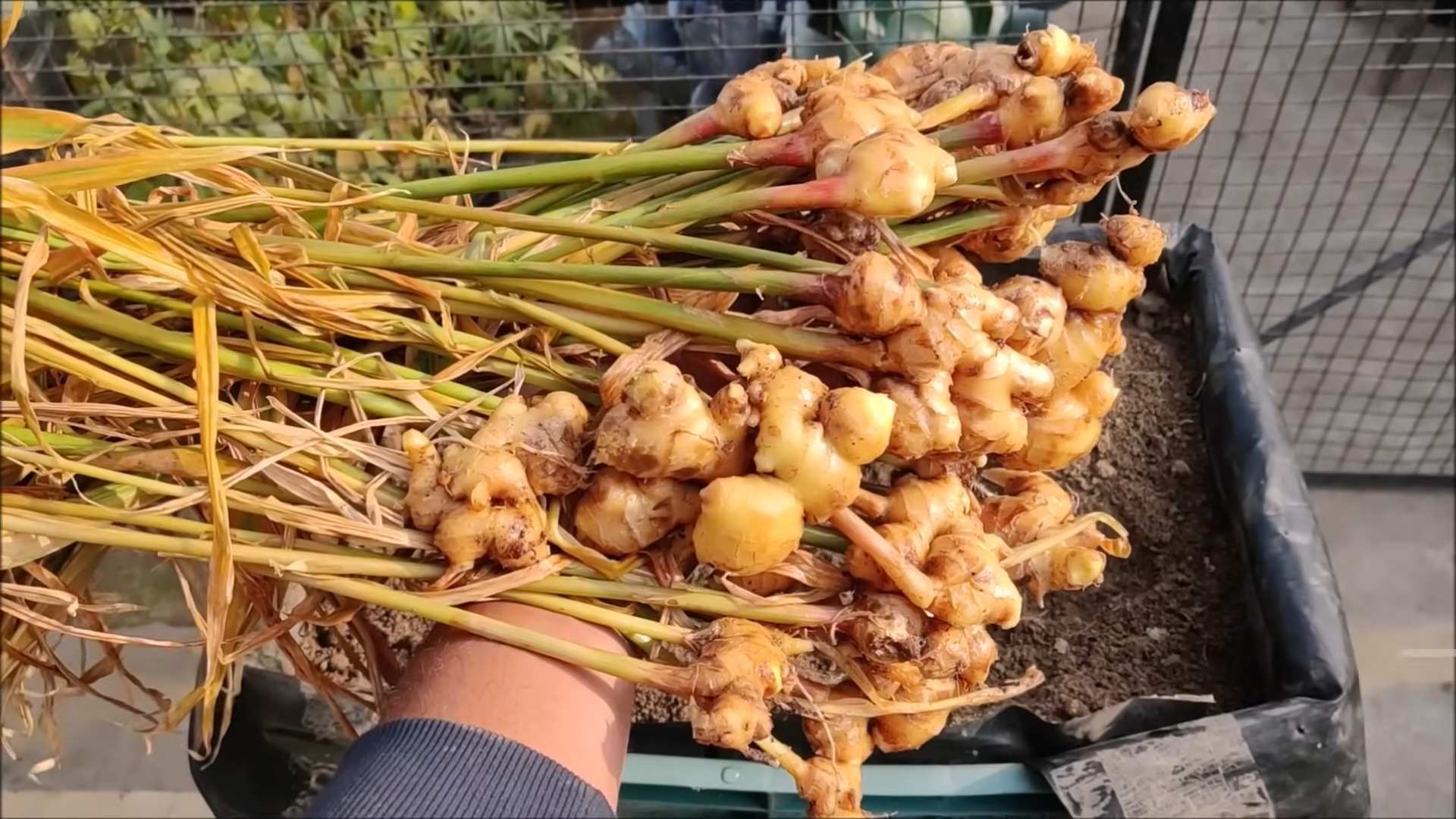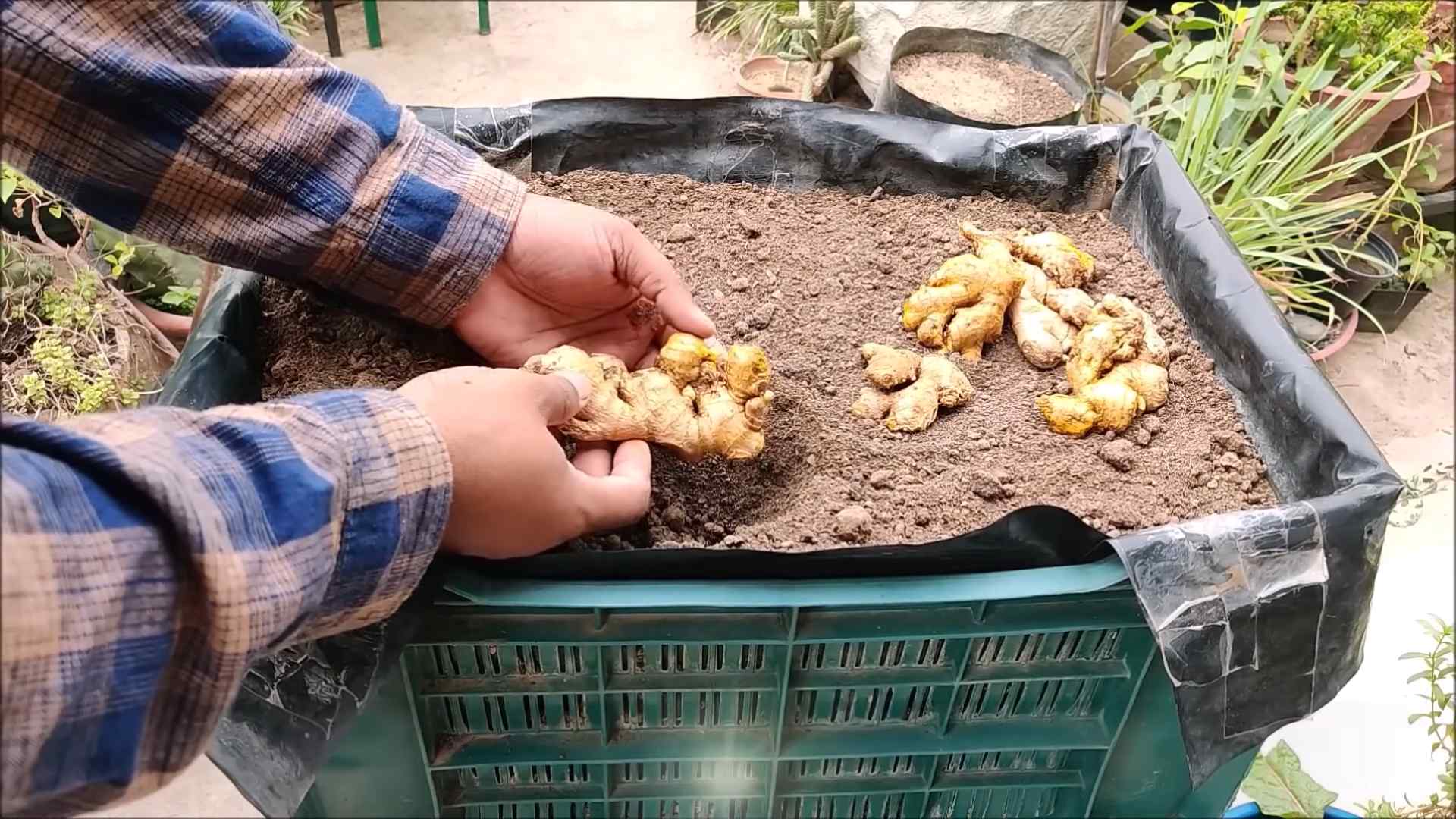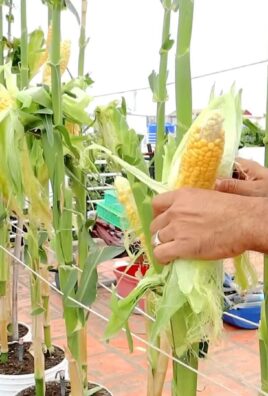Growing Ginger at Home can seem like a daunting task, reserved for seasoned gardeners with sprawling landscapes. But I’m here to tell you a secret: you don’t need acres of land or a green thumb of mythical proportions to cultivate your own fresh, flavorful ginger! In fact, with a few simple tricks and a little DIY spirit, you can enjoy the satisfaction of harvesting your own ginger right from your kitchen windowsill or backyard.
Ginger, with its fiery zest and incredible health benefits, has been prized for centuries. Originating in South Asia, it has been used in traditional medicine and culinary practices across cultures for millennia. From soothing upset stomachs to adding a kick to your favorite stir-fries, ginger is a versatile ingredient that deserves a place in every home.
Why buy ginger from the store when you can growing ginger at home? Not only is it incredibly rewarding, but it also allows you to control the growing process, ensuring you have access to fresh, organic ginger whenever you need it. Plus, let’s be honest, there’s something undeniably cool about telling your friends, “Oh, this ginger? I grew it myself!” This DIY guide will walk you through the entire process, from selecting the perfect ginger rhizome to harvesting your very own homegrown spice. Get ready to unleash your inner gardener and embark on a ginger-growing adventure!

Growing Ginger at Home: A DIY Guide
Hey there, fellow plant enthusiasts! Ever thought about growing your own ginger? It’s surprisingly easy and rewarding, and having fresh ginger on hand for cooking and teas is a total game-changer. I’m going to walk you through everything you need to know to successfully grow ginger right in your own home. Let’s get started!
Choosing Your Ginger Rhizome
First things first, you need a ginger rhizome (that knobby root-like thing you buy at the grocery store). But not just any ginger will do. Here’s what to look for:
* Look for plumpness: Choose a rhizome that’s firm and plump, not shriveled or dried out.
* Eyes are key: The rhizome should have visible “eyes” – these are small buds or growth points that look like little bumps. The more eyes, the better!
* Organic is best: Opt for organic ginger if possible. Non-organic ginger is often treated with growth inhibitors to prevent sprouting, which is exactly what we want to encourage.
* Soak it if needed: If you can only find non-organic ginger, don’t worry! Soak it in water overnight. This can help wash away some of the growth inhibitors.
Preparing the Ginger Rhizome
Okay, you’ve got your ginger. Now it’s time to prep it for planting.
1. Soak the rhizome: Soak the ginger rhizome in lukewarm water for 12-24 hours. This rehydrates it and encourages those eyes to wake up.
2. Cut if necessary: If your rhizome is large, you can cut it into smaller pieces, making sure each piece has at least one or two eyes. I like to use a clean, sharp knife for this.
3. Let it callous: After cutting, let the pieces sit out in a warm, dry place for a day or two to allow the cut surfaces to callous over. This helps prevent rot.
Choosing the Right Pot and Soil
Ginger needs the right environment to thrive. Here’s what I recommend:
* Pot size matters: Choose a wide, shallow pot rather than a deep one. Ginger roots grow horizontally, so a wider pot gives them more room to spread out. A pot that’s at least 12 inches wide and 6-8 inches deep is a good starting point.
* Drainage is crucial: Make sure your pot has drainage holes! Ginger doesn’t like sitting in soggy soil.
* Well-draining soil: Use a well-draining potting mix. A mix of potting soil, compost, and perlite or vermiculite works well. I usually go for a 1:1:1 ratio. The compost provides nutrients, while the perlite or vermiculite improves drainage.
Planting Your Ginger
Now for the fun part – planting!
1. Fill the pot: Fill your pot with the potting mix, leaving about an inch or two of space at the top.
2. Place the rhizome: Place the ginger rhizome on top of the soil, with the eyes facing upwards.
3. Cover lightly: Cover the rhizome with about 1-2 inches of soil.
4. Water gently: Water the soil gently until it’s moist but not soggy.
Caring for Your Ginger Plant
Ginger needs consistent care to grow well. Here’s what I do:
* Location, location, location: Place your pot in a warm, humid location with indirect sunlight. Ginger loves bright light, but direct sunlight can scorch the leaves. An east-facing window is ideal.
* Watering: Keep the soil consistently moist, but not waterlogged. Water when the top inch of soil feels dry to the touch. I usually water every few days, but it depends on the humidity and temperature.
* Humidity: Ginger thrives in humid environments. If your home is dry, you can increase humidity by misting the plant regularly, placing the pot on a tray filled with pebbles and water (making sure the bottom of the pot isn’t sitting in the water), or using a humidifier.
* Fertilizing: Feed your ginger plant every few weeks with a balanced liquid fertilizer. I like to use a diluted solution of fish emulsion or seaweed extract.
* Temperature: Ginger prefers temperatures between 65°F and 90°F (18°C and 32°C). Avoid exposing it to cold drafts or extreme temperature fluctuations.
Harvesting Your Ginger
Patience is key! It takes time for ginger to mature.
1. When to harvest: You can start harvesting ginger about 8-10 months after planting. The leaves will start to turn yellow and die back, which is a sign that the rhizome is ready to harvest.
2. Harvesting options: You have two options for harvesting:
* Partial harvest: You can carefully dig around the edges of the pot and harvest a few pieces of ginger, leaving the rest to continue growing.
* Full harvest: You can dump the entire pot out and harvest all of the ginger at once.
3. How to harvest: Gently dig around the rhizome and lift it out of the soil. Be careful not to damage the roots.
4. Cleaning and storing: Wash the harvested ginger thoroughly and let it dry. You can store it in the refrigerator for a few weeks or freeze it for longer storage.
Troubleshooting
Sometimes things don’t go as planned. Here are a few common problems and how to fix them:
* Yellowing leaves: This could be a sign of overwatering, underwatering, or nutrient deficiency. Check the soil moisture and adjust your watering accordingly. If the soil is consistently moist, let it dry out a bit before watering again. If the soil is dry, water more frequently. You can also try fertilizing the plant.
* No growth: This could be due to a lack of light, warmth, or humidity. Make sure your plant is getting enough light and warmth, and increase humidity if necessary. It could also be that the rhizome you planted was not viable.
* Rotting rhizome: This is usually caused by overwatering or poor drainage. Make sure your pot has drainage holes and that you’re not overwatering the plant. If the rhizome is rotting, remove it from the pot and discard it. Start with a fresh rhizome and make sure to use well-draining soil.
* Pests: Ginger can be susceptible to pests like aphids and spider mites. Inspect your plant regularly and treat any infestations promptly with insecticidal soap or neem oil.
Propagating Ginger
Once you’ve successfully grown ginger, you can easily propagate it to create more plants!
1. Divide the rhizome: When you harvest your ginger, you can divide the rhizome into smaller pieces, making sure each piece has at least one or two eyes.
2. Let it callous: Let the pieces sit out in a warm, dry place for a day or two to allow the cut surfaces to callous over.
3. Plant the pieces: Plant the pieces in individual pots, following the same planting instructions as before.
Enjoy Your Homegrown Ginger!
And there you have it! Growing ginger at home is a simple and rewarding project that anyone can do. With a little patience and care, you’ll be enjoying fresh, homegrown ginger in no time. I love adding it to my stir-fries, teas, and smoothies. It adds such a wonderful flavor and a healthy boost. Happy growing!

Conclusion
So, there you have it! Growing ginger at home is not only surprisingly simple, but it’s also incredibly rewarding. Imagine the satisfaction of harvesting your own fresh, flavorful ginger root whenever you need it, knowing exactly where it came from and how it was grown. Forget those bland, store-bought rhizomes that have been sitting on shelves for weeks. With this DIY trick, you’ll have access to vibrant, aromatic ginger that will elevate your cooking and beverages to a whole new level.
This isn’t just about saving a few dollars; it’s about connecting with nature, learning a new skill, and enjoying the unparalleled taste of homegrown produce. The process itself is therapeutic, offering a welcome respite from the hustle and bustle of daily life. Plus, you’ll have a beautiful, leafy plant to admire, adding a touch of greenery to your indoor or outdoor space.
But the benefits don’t stop there. Think about the possibilities! You can experiment with different varieties of ginger, each with its unique flavor profile. Try growing baby ginger for its tender, milder taste, perfect for pickling or adding to salads. Or, if you’re feeling adventurous, explore some of the more exotic ginger cultivars available online.
Variations to consider:
* Container Size: While we recommend a specific size, feel free to experiment with larger containers for potentially larger yields. Just remember to adjust watering and fertilizing accordingly.
* Soil Amendments: Enhance your soil mix with additions like worm castings or compost tea for an extra boost of nutrients.
* Growing Medium: While potting mix is ideal, you can also try a soilless mix like coco coir or perlite, especially if you’re prone to overwatering.
* Climate Considerations: If you live in a colder climate, consider bringing your ginger plant indoors during the winter months. A sunny windowsill or grow light will help it thrive.
* Ginger Tea Garden: Plant ginger alongside other herbs like mint, lemon balm, and turmeric to create a dedicated tea garden.
We wholeheartedly encourage you to give this DIY trick a try. It’s a fun, educational, and ultimately delicious experience. Don’t be intimidated if you’ve never grown anything before; ginger is surprisingly forgiving. With a little patience and care, you’ll be harvesting your own homegrown ginger in no time.
And most importantly, we want to hear about your experience! Share your photos, tips, and challenges in the comments below. Let’s create a community of home ginger growers and learn from each other. What variety of ginger did you choose? What challenges did you face, and how did you overcome them? Your insights could be invaluable to other aspiring gardeners. So, grab a ginger rhizome, get your hands dirty, and embark on this exciting journey of growing ginger at home. You won’t regret it!
Frequently Asked Questions (FAQ)
What kind of ginger should I use to start growing?
The best ginger to use for starting your own plant is fresh, plump ginger root from the grocery store. Look for pieces that are firm, with visible “eyes” or buds. Organic ginger is often recommended, as it’s less likely to have been treated with growth inhibitors. Avoid ginger that looks shriveled, moldy, or overly soft. You can also purchase specific ginger varieties online from reputable seed companies. These varieties might offer unique flavors or growth characteristics compared to standard grocery store ginger.
How long does it take to grow ginger at home?
Generally, it takes around 8-10 months from planting to harvest mature ginger. However, you can start harvesting baby ginger (which has a milder flavor) as early as 4-6 months. The exact timeframe depends on factors like climate, growing conditions, and the specific ginger variety. Be patient, and you’ll be rewarded with a bountiful harvest!
What are the ideal growing conditions for ginger?
Ginger thrives in warm, humid environments with partial shade. It prefers well-draining soil that is rich in organic matter. The ideal temperature range is between 65°F and 90°F (18°C and 32°C). Avoid exposing your ginger plant to direct sunlight, which can scorch the leaves. Consistent moisture is crucial, but avoid overwatering, which can lead to root rot.
How often should I water my ginger plant?
Water your ginger plant regularly, keeping the soil consistently moist but not waterlogged. Check the soil moisture by sticking your finger about an inch deep. If it feels dry, it’s time to water. During the warmer months, you may need to water more frequently. Reduce watering during the cooler months when the plant’s growth slows down.
What kind of fertilizer should I use for ginger?
Ginger benefits from regular feeding with a balanced organic fertilizer. Look for a fertilizer with an NPK ratio (nitrogen, phosphorus, potassium) of around 10-10-10 or 14-14-14. You can also use compost tea or worm castings to provide essential nutrients. Fertilize every 2-3 weeks during the growing season (spring and summer).
My ginger plant’s leaves are turning yellow. What’s wrong?
Yellowing leaves can indicate several issues. Overwatering is a common culprit, as it can lead to root rot. Ensure your pot has adequate drainage and that you’re not watering too frequently. Underwatering can also cause yellowing, so check the soil moisture regularly. Nutrient deficiencies can also be a factor. Try fertilizing with a balanced organic fertilizer. Finally, pests like spider mites can also cause yellowing leaves. Inspect your plant carefully for any signs of infestation.
Can I grow ginger indoors?
Yes, you can absolutely grow ginger indoors, especially if you live in a colder climate. Choose a pot with good drainage and use a well-draining potting mix. Place the pot in a location that receives bright, indirect sunlight. You may need to supplement with a grow light if you don’t have enough natural light. Maintain consistent moisture and humidity levels.
How do I harvest ginger?
To harvest ginger, gently dig around the plant and lift the rhizome from the soil. You can harvest the entire rhizome or just a portion of it, leaving the rest to continue growing. If you’re harvesting baby ginger, you can harvest it earlier when the rhizomes are smaller and more tender. After harvesting, wash the ginger root thoroughly and store it in the refrigerator or freezer.
How do I store harvested ginger?
Freshly harvested ginger can be stored in the refrigerator for up to a few weeks. Wrap it in a paper towel and place it in a plastic bag to prevent it from drying out. For longer storage, you can freeze ginger. Peel and chop the ginger into smaller pieces, then freeze them in a single layer on a baking sheet. Once frozen, transfer the pieces to a freezer bag or container. You can also grate the ginger before freezing it.
Can I grow ginger from store-bought ginger that has already sprouted?
Yes, you can absolutely grow ginger from store-bought ginger that has already sprouted. In fact, this is a great way to ensure that your ginger is viable and ready to grow. Simply follow the same planting instructions as you would for unsprouted ginger. The sprouts will quickly grow into new shoots, and you’ll be well on your way to harvesting your own homegrown ginger.





Leave a Comment